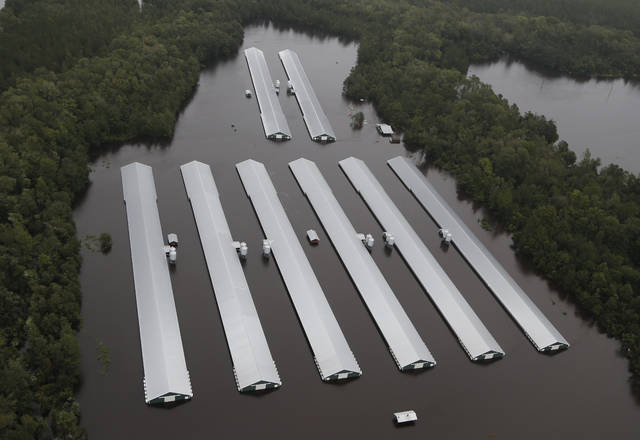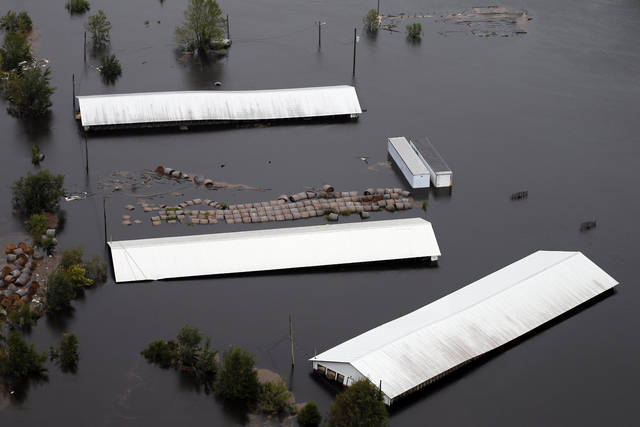5,500 hogs, 3.4 million chickens and turkeys drown in Florence aftermath

ASSOCIATED PRESS
Chicken farm buildings are inundated with floodwater from Hurricane Florence near Trenton, N.C.

ASSOCIATED PRESS
Farm buildings are inundated with floodwater from Hurricane Florence near Trenton, N.C.


For Chris Smith, whose North Carolina farm is home to 30,000 chickens and 150 acres of sweet potatoes, the fight to survive Hurricane Florence is not yet over.
As torrential rains from the storm filled local waterways and flooded nearby roads, Smith, one of hundreds of local farmers in a state known for its poultry and hog operations, found himself cut off from supplies, power and any way to move his birds out.
The ferocity of the storm was surprising, according to Smith. “We thought we weren’t in a flood-prone area, but we had a pretty good scare,” he said. He rationed the feed he had on-hand as best he could, and used 250 gallons of diesel per day to keep his generators running.
Now Smith, who counts himself lucky that his flock survived, is looking to quickly move his chickens to processing plants before the weekend, when more showers are forecast and the nearby Neuse River may flood further. He’s not alone. Seeking to minimize deaths from a storm that’s already killed millions of animals, farmers are turning to helicopters, boats and heavy trucks to supply farms stranded by flooding and ebris.
An estimated 5,500 hogs and 3.4 million chickens and turkeys have already died as a result of Florence, which hit landfall Friday. Six days later, flooding remains a problem, with some roads still impassable and some rivers still near cresting.
Many of the state’s 2,100 hog farms “are returning to normal,” according to the North Carolina Pork Council. But about a dozen still remained unreachable as of Thursday morning, Andy Curliss, the group’s leader, said.
Don't miss out on what's happening!
Stay in touch with breaking news, as it happens, conveniently in your email inbox. It's FREE!
The current push to save animals will, by necessity, be followed by a more grisly effort: The need to quickly and safely get rid of millions of carcasses that carry significant health risks.
Speed is key. As livestock carcasses degrade, they release fluids, gases and a slew of toxic chemical, biological and radiological compounds, the U.S. Department of Agriculture has said. If left untouched, the carcasses can leach into drinking water, and draw flies and rats who can spread pathogens to humans and other livestock.
Buried, Composted or Rendered
The animals killed by Florence will be buried, composted or “rendered” for usable parts, state officials said. The state is working to supply woody materials that can be placed around dead birds, helping them compost more quickly. Several landfills with impermeable linings may take larger carcasses, again topped with woody materials.
Environmentalists, meanwhile, said they remain concerned based on results from past storms, including Hurricane Matthew two years earlier and Hurricane Floyd in 1999, an event that killed at least 20,000 hogs.
“Every time I see the same things: flooded lagoons, chicken houses filled to the roof with dead chicken,” said Rick Dove, an official with the environmental group Waterkeeper Alliance and a resident of New Bern, North Carolina. “We never learn from any of these storms. We have the same problems: dead animals, and feces and urine running down the rivers.”
Farm Inspectors
The final death toll won’t be known for several days, at the minimum. The state is sending inspectors into farm areas to assess the damage, but as of Wednesday they were waiting for flood waters to recede in many areas, the department said in a release.
“We will likely have lost more chickens than anything else,” Jimmy Dixon, a state representative and former turkey farmer, said after touring eastern parts of the state by helicopter Tuesday. “I would say by Thursday we will have a good count.”
The death toll might’ve been worse had many farmers not moved animals out of at-risk areas before Florence hit. About 20,000 pigs were moved to other states, other parts of North Carolina or to the market, the Pork Council’s Curliss said. Turkey producer Butterball LLC lost only about 30,000 birds, or about 0.2 percent of its total in the state, after having relocated some turkeys, spokeswoman Christa Leupen said.
Chicken flocks weren’t all that were hit in Kinston County, where’s Smith flock is located. Smith also grows sweet potatoes, and doesn’t know when he’s going to get back out to harvest them. North Carolina is the top producing state of the tubers, and Smith grows 150 acres of them, only three of which he’s been able to harvest so far.
The potatoes can be picked by hand, but “we use a plow that flips them out of the ground,” he said. “And you can’t flip mud.”



